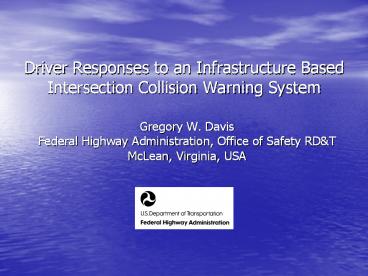Driver Responses to an Infrastructure Based Intersection Collision Warning System - PowerPoint PPT Presentation
Title:
Driver Responses to an Infrastructure Based Intersection Collision Warning System
Description:
Driver Responses to an Infrastructure Based Intersection Collision Warning System Gregory W. Davis Federal Highway Administration, Office of Safety RD&T – PowerPoint PPT presentation
Number of Views:84
Avg rating:3.0/5.0
Title: Driver Responses to an Infrastructure Based Intersection Collision Warning System
1
Driver Responses to an Infrastructure Based
Intersection Collision Warning System
- Gregory W. DavisFederal Highway Administration,
Office of Safety RDTMcLean, Virginia, USA
2
The Red-Light Running Problem
- Red-light violations attributed annually
- 200,000 crashes
- 178,00 injuries
- 920 deaths
3
Current FHWA Sponsored Research and Development
- Intersection Decision Support system research
includes - Warning the potential red-light violator
- Warning the potential victim of the violator
- Virginia Tech Transportation Institute conducting
violator warning studies - FHWA Office of Safety RDT conducting victim
warning studies
4
Warning Potential Victims
- Warning must come when potential victim is on
close approach to intersection - Response to warning must be
- Intuitive
- Rapid
- Robust
5
Research Question
- What would drivers do when given novel,
unexpected, warning? - What proportion would avoid collision?
- Would accelerated phase change be enough?
- Are more intense warnings more effective?
- Does driver age matter?
6
Warning Conditions
- 4 s amber (Control)
- ½ s amber
- Immediate red ball with supplemental flashing red
lights, illuminated stop symbol, and white strobe
lights - Preceding (3) plus in-pavement red lights and
intelligent rumble strips
7
Warning Conditions (continued)
- All warnings triggered at either 215 ft or 180 ft
from the intersection
8
Condition 3
9
Condition 4
10
Procedures
- Driving Simulator
- Participants told this was a study of traffic
signal timing - Drove through 32 signalized intersections
separated by ½ miles - Infrequent need to stop
- No signal changes to red near intersection
- Warning occurred at 33rd Intersection
11
Procedures (continued)
- Drivers instructed to
- Maintain 45 mph
- Continue straight on the current road
- Obey all traffic laws
- Otherwise, drive as they normally would
12
Research Design
- Four independent (between) groups design
- Half the participants were over 65 years of age
or older - Groups balanced for age and gender
13
Results
Condition Not Delayed Delayed
1. Control (4 s Amber) 69 31
2. ½ s Amber 51 49
3. Flashing Lamps and Sign 39 61
4. Added Rumble Strips and In-Road Lights 33 67
14
Results (continued)
15
Conclusions
- A substantial proportion of drivers will respond
sufficiently if given a compelling warning - However, more drivers responded than expected in
the control condition - All driver age groups may benefit age
difference for reaction times was not detected - Further research and development is needed to
determine driver responses in platoons - A Field Validation Study is currently underway at
VTTI






























